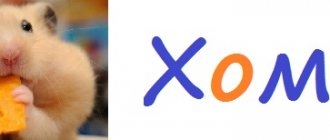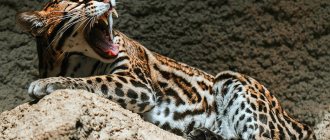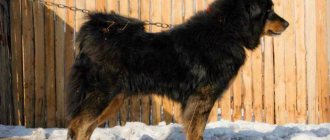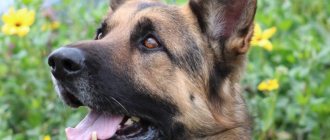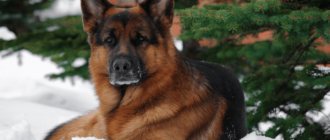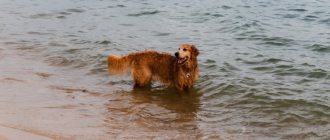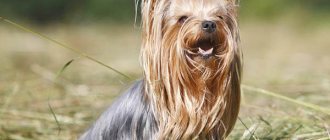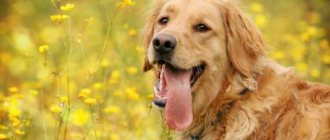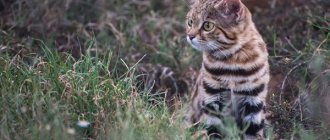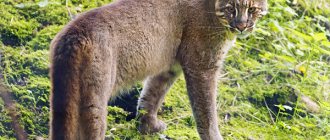Afghan Hound
A fluffy breed like the Afghan Hound is one of the oldest long-haired breeds. Outwardly, Afghan hounds are rather aristocratic: they have long paws and literally shining satin hair, which creates the effect of bell-bottom trousers at the tips of their paws. The peculiarities of the head position and the same aristocratic posture create the impression of extraordinary sophistication.
When the Afghan Hound runs, its thick fur flutters in the wind like a magical robe. This long-haired breed often has an elongated, wedge-shaped head. The muzzle is emphasized and elongated. The eyes resemble triangles and are set obliquely.
Where to buy a South Russian Shepherd puppy
To buy a dog, it is better to choose trusted nurseries whose breeders have a good reputation. Otherwise, there is a high risk of purchasing an animal that is not purebred or has genetic diseases. Popular nurseries include:
- “Russian Giant” - https://rusvelikan.ru/;
- “White Beast” - https://belaya-bestia.narod.ru/;
- “White Witch” - https://belayavorozheya.ucoz.ru/.
What is the price
A price that is too low should raise suspicion. South Russian Shepherd puppies cost an average of 15,000 rubles. Such a pet will have a pedigree and all the necessary documents. The specific price depends on what kind of parents the puppy has and where you make the purchase. The cost will be lower if purchased secondhand. If the price is very low, you should not count on the pet being truly purebred.
How to decide which dog to have in your apartment
Problematic or not, demanding or with character - neither breeders nor experienced dog breeders will ever characterize their pets this way. Each breed has its own characteristics, which may correspond to the lifestyle and character of the owner, and then it is perceived as ideal. Or they may not correspond, and then keeping a pet causes a lot of trouble for the owner.
This happens when a person chooses an overly active and mobile dog that needs regular walks and daily games. But at the same time, the owner does not have the time or desire to spend hours on the street with the pet. Because of this, the dog may begin to feel sad, show stubbornness and disagreement with the owner, and damage furniture, shoes and clothes in the apartment when no one is home.
Another equally important aspect is the characteristics of the wool. Breeds with pronounced shedding periods are not suitable for people suffering from allergies. Not every owner is ready to take their pet for grooming every two months and spend money on grooming the dog. Finally, it is important to understand that a pet's fur may have a specific odor, which does not cause problems if the animal lives in the yard of a private house, but will become a serious nuisance in a small apartment.
Fact. There is no “most problem-free dog” for an apartment. There are breeds that are better suited for this than others due to their character, lifestyle, and characteristics of care and education. Therefore, you need to choose a dog, especially the first one, very carefully, weighing all the pros and cons, taking into account the recommendations of breeders and reviews of other owners.
Names for Yorkshire Terrier
The British origin of the dog gives it every right to bear a foreign name. But you shouldn’t focus on aristocratic and noble nicknames. After all, the Yorkshire is a hard worker, a hunter and a helper, and therefore simpler nicknames for Yorkshire terrier boys would be appropriate. Bard, Vince, Jason, Lucky, Mini, Poof, Roger, Smart, Tice, Chuck, Harvey - a set of options that correspond to the character and characteristics of the breed.
Nicknames for girls of the Yorkshire Terrier can be much sweeter and gentle. After all, these creatures do not have such a cool disposition as boys. Therefore, the nicknames Bonya, Busya, Zaya, Mila, Iriska, Lyalya, Fairy, Fifa, Chika, Lapka, Tiffany, Eva are suitable for them.
Shih Tzu
Translated from Chinese, the lion dog is the oldest of dog breeds. For a long time it was banned, as it belonged only to the imperial court. This is a companion dog. They are loving, their love is evenly distributed among all the inhabitants of the house. They cannot stand loneliness and relentlessly follow their owners wherever they go. Thanks to this quality and enormous affection, the Shih Tzu is an excellent companion for the elderly and lonely; they practically do not react to street animals. They can be trained to use a litter tray and become completely indoor dogs also because with age, their long hair can become a big problem for owners on the street. To the question: “Do Shitzus’ eyes fall out?” the answer may be: “Unfortunately, even with a slight blow to the temporal region, this can happen.” If your dog walks among dry grass, then due to infrequent blinking, the eyes become easily clogged. The eyes should be wiped daily with a cotton swab moistened with clean warm water. The fur around the eyes should be carefully combed and even tied up. The cost of a puppy is from 8,000 to 30,000 rubles.
Pomsky
This breed is a cross between a Husky and a Spitz (Pomeranian). Pomskies are not officially recognized by dog handlers, but most dog lovers and experienced dog breeders consider them to be a completely independent breed. Let us note a characteristic feature of the Pomsky: they are characterized by odd eyes.
Among the variety of Pomsky types, dog breeders and simply dog lovers who prefer fluffy breeds value the plush husky and white Pomsky the most. Precisely for its thick and soft-to-touch fur. The brown blue-eyed Pomsky is in less consumer demand.
Norwegian Black Elkhound
A typical northern husky, with a curled tail and a glossy black coat. An all-weather hunting dog that is not afraid of either rain or frost. In addition, it is used as a guard and sled dog.
The Elkhound has a thick coat, longer on the chest, neck and hind legs. Like all northern dogs, it is very susceptible to periodic shedding, so it is not recommended for keeping at home. But the breed does not have a characteristic “dog” smell. He is not very fond of other dogs, but in relationships with people, even strangers, he behaves with restraint.
Care and maintenance
The best option for keeping a South Russian Shepherd is a country house with a plot or a large enclosure from which the pet must be let out to frolic. Even in severe frosts the animal feels comfortable. In a city apartment keeping such a pet, problems arise related to the need for walking and excessive shedding. The dog does not require care, but some procedures must be carried out.
- Lack of this vitamin increases the risk of COVID-19
- 6 reasons for high cholesterol after 50 years for men and women
- What happens to a loan if the bank’s license is revoked
How to care for your fur
The first molt begins at 8 months of age. If tangles form, they will have to be cut off. To wash the coat regularly, a special dog shampoo is required. The frequency of procedures should not exceed 3-4 times a year. Washing is only necessary to maintain the appearance of the coat. The smell of dog is not typical for southerners. When an animal gets wet, it smells like a lamb. You need to teach your pet to comb its fur from an early age. Basic rules for grooming:
- to improve visibility, the bangs need to be thinned out with thinning scissors;
- after the start of active molting in the spring, the undercoat is removed with a special slicker;
- It is not recommended to cut your dog's hair. When the wool becomes too long, it is milled;
- Show dogs must be groomed regularly.
Hygiene procedures
In the ears, if necessary, you also need to thin out the hair using special scissors. When dirt does not accumulate, the dog feels more comfortable. Nail trimming and preventive teeth cleaning are required regularly. If necessary, it is recommended to contact a dental tartar removal clinic. If the dog is not a show dog, then it needs shortening of the hair on its face (beard, bangs, mustache) and in the groin area. Cut off no more than 4-5 cm. In the case of a “clipper” haircut, the risk of developing extensive dermatitis increases. Dogs intended for exhibition cannot be cut.
Long walks
Without movement, the South Russian Shepherd becomes passive. Her depressed mood can be seen in her tired eyes. If an animal remains without physical activity for a long time, it is at risk of developing various diseases. In addition, it shortens the lifespan of the animal. For this reason, it is very important to provide your pet with a daily walk. Walks can be either outside the city or in a deserted area. The dog will happily run after the owner’s bicycle.
Japanese Spitz
A small dog with surprisingly fluffy fur. The breed standard assumes an exclusively white color; other colors, inclusions or blots are considered disqualifying for the breed. The undercoat of the Japanese Spitz is very, very soft, while the outer coat is stiff. The fur stands up and gives the dog an airy appearance.
The distribution of hair over the body of the breed is uneven. There is less hair on the pasterns, ears, and forearms than on other parts of the body. However, in general, Japanese Spitz look quite fluffy.
Brussels griffin
A breed such as the Brussels Griffon is distinguished by the fact that its guard hair is often medium, but it is incredibly thick and resembles a thin wire to the touch. It is believed that the rougher it is, the more valuable the individual. However, unlike dog handlers, amateur dog breeders do not find any special value in this.
The following is also noteworthy: around the eyes, nose, as well as on the cheeks and chin of the Brussels Griffon, the fur is much longer. It forms thick eyebrows, mustaches and beards, so this breed will certainly appeal to absolutely all lovers of fluffy dogs.
Health and hereditary diseases
The South Russian Shepherd is in good health. With proper care, the average life expectancy of a dog is 15-17 years. Due to their large size, few pets survive to this age. High risk due to active growth. If against this background there is an unbalanced diet, then the puppies’ paws change. Purebred dogs rarely get colds, because the breed was bred to work in all weather conditions.
Even a naturally strong immune system cannot protect itself from viruses. Timely vaccinations will help prevent diseases. Among the pathologies characteristic of southerners, the following stand out:
- cataract;
- blood-sucking parasites;
- dermatitis;
- eczema.
Portuguese water dog
No less rare breed than the Hungarian Mudi. It got its name because in the Middle Ages, Portuguese fishermen used it to drive fish into nets. One of the main colors is black. The coat is thick and hard, curly or wavy, and has a water-repellent property. The coat does not require special care; according to standards, a poodle-like haircut is allowed.
Read Guide dogs - breeds for blind people
Dogs of this breed have a very stable psyche and a gentle character; she swims well and loves to do so, so it is not worth bathing her separately. Just like the Giant Schnauzer, the breed is devoid of the specific “dog” smell.
Source
Character and temperament of the South Russian Shepherd
Upon further communication with the dog, one can note not only its beautiful exterior, but also its strong character with a special South Russian temperament. By nature, the shepherd has gained independence. With proper training, the dog makes its own decisions and can herd a herd alone for several days, even without a person nearby. This quality is very important at work, but in training it leads to uncontrollability. The South Russian Shepherd has the following character traits:
- High intelligence. If the dog feels that a strong-willed owner is nearby, then it will behave submissively.
- Instant reaction. Hearing a suspicious sound, the animal reacts to it with lightning speed. At such moments, the pet can show a wayward character.
- Courage. Until the owner gives the command, the pet will not allow anyone into the territory entrusted to him.
- Dominance. Her dogs show at an early age. The owner must stop inappropriate behavior without influencing the animal's instincts.
Relationships with the owner and others
The pet gives its love only to its owner, whose commands are carried out unquestioningly. The dog does not show hostility towards other family members. Even with proper socialization, southerners threaten a child, especially a small one. The South Russian Shepherd Dog does not get along well with other people's pets. She only accepts those she grew up with. The dog is uncomfortable working in a pack because of the desire to dominate. This is especially evident when communicating with animals that are less physically developed. If strangers arouse suspicion in the dog, he will attack without warning.
Features of training and education
The process of training an animal should be step-by-step. Learning will be easier in a playful way. The owner needs to motivate the pet without exerting pressure. Otherwise, the shepherd begins to prove its independence, which reduces the effectiveness of training. The animal's protective instinct manifests itself at the age of 8-10 months. The four-legged creature attacks a stranger as soon as it sees him.
The transition period in the first 1-2 years is more pronounced in Yuzhaks compared to other herding breeds. In females it is noticeably smoothed out, but males, even physically mature ones, can behave like puppies. Aggression during this period is combined with uncertainty and cowardice. At this time, the owner must maintain his position as a leader, countering the whims with firmness and severity. When training, it is important to follow simple rules:
- due to the choleric nature of the pet, more attention should be paid to inhibitory commands;
- it is necessary to achieve unquestioning execution of commands;
- the subordination team must be trained daily;
- The Yuzhaka should be raised by only one person, whom the dog considers the owner;
- Commands must be given in a firm and clear voice.
Description of the breed
The breed was originally bred to herd sheep and protect them from wolves. To do this, the puppies were instilled with the necessary qualities and only those representatives who had the best character and exterior were selected. The result of selection was dogs that fully coped with the task. To guard a flock of 1,500 sheep, 3-4 dogs were enough. Yuzhaks aggressively defended not only the herd, but also the owner’s territory and their home. Today the breed is used for security and watchdog purposes. Some representatives make good rescuers or detectives.
Appearance
The animal's physique is powerful with appropriate physical strength, developed muscles and bones. Even in puppyhood, the pet should not appear “raw.” The height of an adult animal exceeds the average: for a male - at least 65 cm, for a female - optimally 62-66 cm. The breed has pronounced sexual dimorphism. The sizes of dogs differ depending on gender, but the weight remains proportional to the build and ranges from 48-50 kg. Body weight should not be less than 35 kg.
Breed standard
In 1931, the first breed standard was approved, for which a description of the typical characteristics of the Yuro, noted by dog handler L.P. Sabaneev, was used. A shaggy dog is characterized by wavy locks all over its body, making it look like a fine-fleeced sheep. This gave the pet an advantage when guarding the herd. The standard also describes other characteristics of the breed:
- The head is moderately long, has a convex nape, and a forehead of medium width. When viewed from above, it tapers from the forehead to the muzzle. The transition to the back from the frontal part is smoothed, but stands out due to the developed cheekbones and pronounced eye sockets. The lips fit tightly to the jaws, the cheeks are flat.
- Complete set of teeth, scissor bite. The incisors are set vertically, on parallel lines. The front incisors can grow together, the premolars are moderately inclined. Teeth broken off during work are allowed, as long as they do not affect the bite.
- The nose is wide, black, sometimes lightened pigmentation is allowed.
- The eyes are oval, dark brown, expressive, widely set. An almond-shaped incision or slanted posture is not typical for the JRO. The eyelids fit tightly and are completely black.
- The ears are triangular in shape, close to the head, but should not be raised on the cartilage at the base.
- The body is strong, muscular, but not squat. The neck is oval, muscular, carried without a pronounced bend.
- The limbs are set wide, confidently, have a lean build, and their muscles are well developed. When viewed from the front, the paws are perfectly straight.
- The tail is set low, thick, and has a classic length down to the hocks. If the South Russian Shepherd is concentrated, then the tail is full to the line of the back. In a calm state, he rushes freely. Fusion of the last 1-3 vertebrae of the tail is allowed. The tip can be wrapped in half or a full ring.
- 10 Early Symptoms of Multiple Sclerosis
- Who can get coronavirus again?
- Potato cutlets
Color and coat type
The dog is recognizable and famous for its luxurious coat. It has a thick and soft undercoat, the length of the spine is at least 10 cm, but in young dogs it is taken into account last. Among adult individuals, representatives with guard hairs of 20 cm or more have an advantage. The dog's coat has a dense, semi-rigid structure. The spine is stiffer on the paws, head and tail. The coat is shaggy and straight, with a slight break. On the back of the nose, the hair falls in an even parting. According to the breed standard, not only white color is allowed, but also other color options:
- light gray;
- fawn-gray and even light fawn;
- a combination of gray, fawn and piebald shades;
- gray-piebald, fawn-piebald - acceptable;
- lightened with large markings in a fawn and gray palette.
Disqualifying features
There are representatives of the breed with deviations from the standard. They relate to both the behavior and appearance of the animal. Defects, serious deficiencies and disqualifying defects are highlighted. The latter do not give the dog the right to participate in breeding. Among the disqualifying characteristics regarding behavior are the following:
- choleric;
- cowardice;
- uncontrollable aggressiveness;
- sideways movement, ambling.
Any dog with obvious behavioral abnormalities must be disqualified. The same applies to physical defects from the following list:
- square body format;
- blue, black, red, tri-color, brown;
- pronounced mask, saddle cloth;
- lack of pigmentation of the eyelids, pink lips, spotted or pink nose;
- docked tail, bob tail;
- short hair;
- rounded skull;
- whitish, blue, whitish eyes;
- turning of the eyelids;
- deviation from the growth standard by 3 cm or more.
Schipperke
Another black shepherd, only from Belgium. True, it can be called a shepherd dog only by its habits and official duties. In fact, she looks more like a Spitz, both in appearance and in size. The average weight of such a black “devil” is 4-6 kg.
Read Top 20 most expensive dogs - for the price of a good car
Breed standards allow only black color of the animal's two-layer coat. Due to the fact that the hair on the Schipperke's neck is slightly longer, a mane is formed that looks like a lion's. The smoky black coat of this dog breed needs to be brushed several times a week, and every day during shedding. It is very suitable for those owners who would like to have a shepherd, but the square meters do not allow this.
What to feed your pet
The key to good health of the South Russian Shepherd is proper balanced nutrition. It involves observing the frequency of feeding and matching the volume of feed to the weight and age of the animal. Per kilogram of weight of an adult animal there should be about 30 g of dry food and 50 g of liquid food. The nutrient norm is higher for those individuals who are involved in the professional sphere. An adult South Russian Shepherd needs 250 g of protein, 60 g of fat and 450 g of carbohydrates. For the digestive system to function normally, 40 g of fiber is required.
An adult shepherd is fed 2 times a day. If you choose exclusively dry food, it is better to give preference to certified brands. It is recommended that the puppy’s diet be made up of natural products, including low-fat cottage cheese, boiled vegetables and a variety of cereals. The diet of adult shepherd dogs consists of:
- sea fish;
- rice and buckwheat;
- raw beef meat;
- offal;
- chicken eggs;
- cottage cheese;
- kefir
Bobtail
The Bobtail breed is characterized by the presence of abundant, dense and curly hair. Adults resemble rather medium-sized wooly clouds, which either gracefully or randomly fly towards their owners. When Bobtails gallop, they resemble springs, and when they walk or trot, it seems like they are ambling a fluffy foal.
Medium-sized oval eyes, harmoniously set, as well as developed brow ridges and relatively short paws - this is what makes such a fluffy pet like the Bobtail a real favorite of any dog breeder.
Russian greyhound
Sophisticated and elegant, Russian greyhounds are lean, incredibly beautiful and at the same time fluffy. They move easily and gracefully, waving their long thin tails with lush fur. The body is covered with long, often wavy hair. On the ears and on the muzzle, as well as on the head, the fur is much shorter, but on the neck there is a lush and thick dewlap, which easily allows you to distinguish the breeds from others.
The coat color of Russian greyhounds is often spotted and piebald. This rule does not apply to blue and chocolate greyhounds.
Papillon
Dog lovers, especially connoisseurs of fluffy dog breeds, often call Papillons butterflies. Exactly butterflies! The reason for this is simple and lies in the fact that the breed has incredibly fluffy ears, raised and such, the hair from which falls down in the form of wings.
Read: Medium-sized dogs are ideal pets for an apartment
As for the hair in general: it is long, fluffy, and soft to the touch. The color is often bicolor: white fur predominates, on which red or brown spots may occasionally be found.
